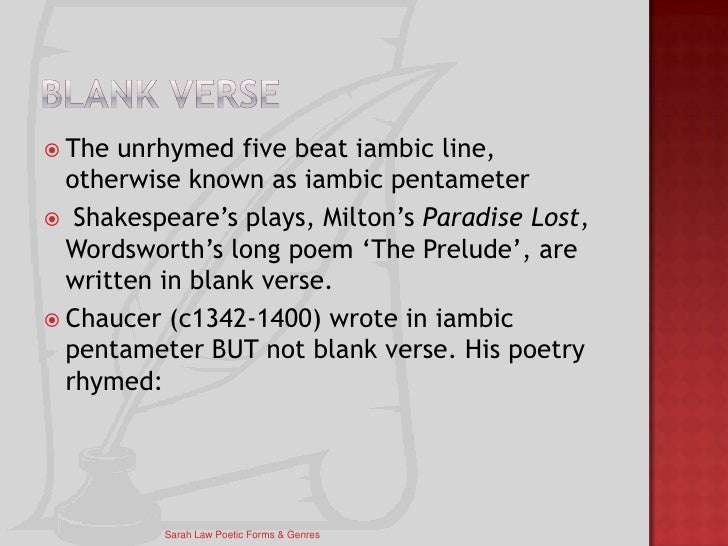

You can diagram any Shakespearean sonnet as:

That is also the description of a “Shakespearean Sonnet.” (The other major sonnet form, the Petrarchan Sonnet, is also in iambic pentameter, with the first 8 lines (the octave) rhymed abba/abba and the final 6 lines (the sestet) rhymed cdd/ece. This will allow you to describe the form of the poem – in the case of Sonnet 73, the form is iambic pentameter, three stanzas rhymed abab cdcd efef, and a couplet (two line stanza) rhymed gg. To scan a poem means to mark the stressed and unstressed syllables, as I have in all the examples above, divide each line into feet, and mark the rhyme scheme, using a letter of the alphabet to the right of each line. So the rhyme scheme of Frost’s “Dust of Snow” is “AA, BB.” The rhyme scheme of the form known as a Shakespearean Sonnet is ABAB CDCD EFEF GG. You can describe any rhyme scheme (a repeated pattern of end-rhymes) by labeling the first end-word with an “A,” the next new-sounding end-word with a “B” and so on. Unless you plan to get into Greek or Middle Eastern verse forms, you needn’t trouble (Hardly any modern English poetry is structured in line lengths beyond pentameter, so Upon those boughs which shake against the cold,īare ruined choirs, where late the sweet birds sang. When yellow leaves, or none, or few, do hang That time of year thou mayst in me behold Pyrrhic: the house on the hillside (“on the” is unaccented/unaccented

The substitutive feet (feet not used as primary, instead used to supplement and vary a primary foot) are referred to using these terms: From the late 19th Century on, poets have been varying those “rules,” or just saying to hell with them entirely, as Whitman did.Īnapestic: in the mist (unaccented/unaccented/accented)ĭactylic: gracefully (accented/unaccented/unaccented)Īmphibrachic: descending (unaccented/accented/unaccented In classical metric practice, no foot can contain more than one stressed syllable, or more than two unstressed syllables. For instance, the word “podiatrist”ĭivides into two metric feet, both iambic: po di a trist. In this example, you see four stressed syllables in each line, so the metrical scheme of this stanza is iambic tetrameter, a very common pattern in modern English poetry.Ī metric foot is not the same as a word. That kind of foot ( _ / ) is called an iamb, and if it is the most common foot within a poem, the meter is described as iambic. ( b)Īs you can see, most of the rhythmic units are composed of one unstressed and one stressed syllable (The way a crow.) Example:Īnd saved some part of a day I had rued. So, for a long time, much poetry was written in regular rhythmic patterns called stanzas, with a given number of accents (also called “stresses”) per line and a pattern of end-rhymes, usually called a rhyme scheme.
Scansion examples shakespeare how to#
People probably invented poetry to help them remember things they wanted to remember – what their gods and ancestors did, how to get from one place to another, what plants were good to eat and what plants were poisonous – all sorts of things that rhythmic patterns and regular rhyme schemes made easier to remember.


 0 kommentar(er)
0 kommentar(er)
